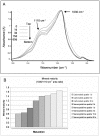Mineral maturity and crystallinity index are distinct characteristics of bone mineral
- PMID: 20091325
- PMCID: PMC2958843
- DOI: 10.1007/s00774-009-0146-7
Mineral maturity and crystallinity index are distinct characteristics of bone mineral
Abstract
The purpose of this study was to test the hypothesis that mineral maturity and crystallinity index are two different characteristics of bone mineral. To this end, Fourier transform infrared microspectroscopy (FTIRM) was used. To test our hypothesis, synthetic apatites and human bone samples were used for the validation of the two parameters using FTIRM. Iliac crest samples from seven human controls and two with skeletal fluorosis were analyzed at the bone structural unit (BSU) level by FTIRM on sections 2-4 mum thick. Mineral maturity and crystallinity index were highly correlated in synthetic apatites but poorly correlated in normal human bone. In skeletal fluorosis, crystallinity index was increased and maturity decreased, supporting the fact of separate measurement of these two parameters. Moreover, results obtained in fluorosis suggested that mineral characteristics can be modified independently of bone remodeling. In conclusion, mineral maturity and crystallinity index are two different parameters measured separately by FTIRM and offering new perspectives to assess bone mineral traits in osteoporosis.
Conflict of interest statement
The authors have no conflict of interest.
Figures







Similar articles
-
Effect of hydrazine based deproteination protocol on bone mineral crystal structure.J Mater Sci Mater Med. 2012 May;23(5):1139-48. doi: 10.1007/s10856-012-4593-7. Epub 2012 Mar 3. J Mater Sci Mater Med. 2012. PMID: 22389100
-
Comparison of mineral quality and quantity in iliac crest biopsies from high- and low-turnover osteoporosis: an FT-IR microspectroscopic investigation.Osteoporos Int. 2005 Dec;16(12):2031-8. doi: 10.1007/s00198-005-1992-3. Epub 2005 Aug 9. Osteoporos Int. 2005. PMID: 16088360 Free PMC article.
-
Optimal methods for processing mineralized tissues for Fourier transform infrared microspectroscopy.Calcif Tissue Int. 2002 May;70(5):422-9. doi: 10.1007/s00223-001-1016-z. Epub 2002 Mar 27. Calcif Tissue Int. 2002. PMID: 12055658
-
Vibrational spectroscopic techniques to assess bone quality.Osteoporos Int. 2017 Aug;28(8):2275-2291. doi: 10.1007/s00198-017-4019-y. Epub 2017 Apr 5. Osteoporos Int. 2017. PMID: 28378291 Review.
-
From biomimetic apatites to biologically inspired composites.Anal Bioanal Chem. 2005 Feb;381(3):568-76. doi: 10.1007/s00216-004-2943-0. Epub 2005 Feb 5. Anal Bioanal Chem. 2005. PMID: 15696277 Review.
Cited by
-
Comparison of DNA preservation and ATR-FTIR spectroscopy indices of cortical and trabecular bone of metacarpals and metatarsals.Sci Rep. 2023 Sep 19;13(1):15498. doi: 10.1038/s41598-023-41259-2. Sci Rep. 2023. PMID: 37726341 Free PMC article.
-
The effect of mineral coating morphology on mesenchymal stem cell attachment and expansion.J Mater Chem. 2012 Dec 28;22(48):25288-25295. doi: 10.1039/C2JM33354F. J Mater Chem. 2012. PMID: 25663752 Free PMC article.
-
Effects of 3 years treatment with once-yearly zoledronic acid on the kinetics of bone matrix maturation in osteoporotic patients.Osteoporos Int. 2013 Jan;24(1):339-47. doi: 10.1007/s00198-012-2202-8. Epub 2012 Nov 15. Osteoporos Int. 2013. PMID: 23229465
-
Phase transformations in a human tooth tissue at the initial stage of caries.PLoS One. 2015 Apr 22;10(4):e0124008. doi: 10.1371/journal.pone.0124008. eCollection 2015. PLoS One. 2015. PMID: 25901743 Free PMC article.
-
Morphological and Spectroscopic Study of an Apatite Layer Induced by Fast-Set Versus Regular-Set EndoSequence Root Repair Materials.Materials (Basel). 2019 Nov 8;12(22):3678. doi: 10.3390/ma12223678. Materials (Basel). 2019. PMID: 31717256 Free PMC article.
References
-
- Green J. The physicochemical structure of bone: cellular and noncellular elements. Miner Electrolyte Metab. 1994;20:7–15. - PubMed
-
- Cazalbou S. PhD thesis. University of toulouse; france: 2000.
-
- Cazalbou S, Combes C, Eichert D, Rey C, Glimcher MJ. Poorly crystalline apatites: evolution and maturation in vitro and in vivo. J Bone Miner Metab. 2004;22:310–317. - PubMed
-
- Barry AB, Baig AA, Miller SC, Higuchi WI. Effect of age on rat bone solubility and crystallinity. Calcif Tissue Int. 2002;71:167–171. - PubMed
-
- Ager JW, Nalla RK, Breeden KL, Ritchie RO. Deep-ultraviolet Raman spectroscopy study of the effect of aging on human cortical bone. J Biomed Opt. 2005;10:034012. - PubMed
Publication types
MeSH terms
Substances
LinkOut - more resources
Full Text Sources
Other Literature Sources

